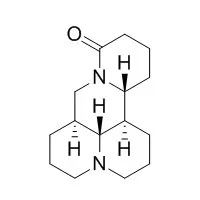| Description: |
Allomatrine can inhibit proliferation and invasion in vitro of human lung cancer A549 cell line by inducing ROS production,promoting apoptosis, arresting cell cycle, inhibiting ubiquitin proteasome and regulating tumor related gene expression. (+)-Allomatrine and (+)-matrine when given i.c.v. may stimulate the descending dynorphinergic neuron, resulting in the stimulation of KORs in the spinal cord, and this phenomenon in turn produces the antinociception in mice.
|
| In vitro: |
| Chinese Pharmaceutical Journal, 2015 , 50 (13) :1111-6. | | Effect and Mechanism of Allomatrine in Proliferation and Invasion in Vitro Inhibition of Human Lung Cancer A549 Cell Line[Reference: WebLink] | To investigate the effect and mechanism of Allomatrine in proliferation and invasion in vitro inhibition of human lung cancer A549 cell line.
METHODS AND RESULTS:
After treatment with Allomatrine, MTS assay was employed to determine the proliferation of cancer cells, flow cytometry to determine the apoptosis rate, cell cycle distribution and intracellular ROS production, transwell assay to determine the cell invasion potential in vitro, adhesion assay to determine the cell adhesion potential in vitro, realtime PCR and Western blotting assay to determine the expression of apoptosis related gene Survivin, Bcl-2 and caspase-3/8, the cell cycle related protein CDK-2, adhesion molecule CD44, matrix metalloproteinases MMP-2/9 and the phosphorylation of AKT, report gene assay to determine the transcription activity of NF-KB and the activity of ubiquitin proteasome. Allomatrine significantly inhibited the proliferation and invasion in vitro of A549 cells, flow cytometry showed that apoptosis rate and ROS production was increased and the cell cycle was halted by G2/M phase, the expression of pro-apoptosis gene caspase-3/8 was upregulated while the anti-apoptosis proteins Survivin and Bcl-2 was downregulated, the expression of CDK-2, CD44 and MMP-2/9 was downregulated, and the phosphorylation of AKT was downregulated, the transcription activity of NF-KB and the activity of ubiquitin proteasome were inhibited after Allomatrine treatment.
CONCLUSIONS:
Allomatrine was able to inhibit proliferation and invasion in vitro of human lung cancer A549 cell line by inducing ROS production, promoting apoptosis, arresting cell cycle, inhibiting ubiquitin proteasome and regulating tumor related gene expression. |
|
| In vivo: |
| Biol Pharm Bull. 2005 May;28(5):845-8. | | Implication of the descending dynorphinergic neuron projecting to the spinal cord in the (+)-matrine- and (+)-allomatrine-induced antinociceptive effects.[Pubmed: 15863891] | We previously reported that either (+)-matrine (matridin-15-one) or (+)-Allomatrine (the C-6 epimer of matrine)-induced antinociceptive effect was attenuated by s.c. pretreatment with a kappa-opioid receptor (KOR) antagonist nor-binaltorphimine (nor-BNI), indicating the critical role of KORs in antinociceptive effects induced by these alkaloids.
METHODS AND RESULTS:
In the present study, we found that i.c.v. administration of either (+)-matrine- or (+)-Allomatrine induced antinociceptive effects in the mouse tail-flick and warm-plate test, whereas these alkaloids when given spinally failed to induce antinociception. In the guanosine-5'-O-(3-[(35)S]thio)trisphosphate ([(35)S]GTPgammaS) binding assay, we demonstrated that neither (+)-matrine nor (+)-Allomatrine produced the stimulation of [(35)S]GTPgammaS binding in the membranes of the spinal cord, indicating that (+)-matrine- and (+)-Allomatrine-induced supraspinal antinociceptive actions was not due to a direct stimulation of KORs by these alkaloids. Therefore, we next investigated the involvement of dynorphin A (1-17) release at the spinal or supraspinal site in (+)-matrine- or (+)-Allomatrine-induced antinociception. The i.c.v. pretreatment with an antiserum against dynorphin A (1-17) could not affect the antinociceptive effect induced by s.c. treatment of (+)-matrine. In contrast, the s.c.-administered (+)-matrine- and (+)-Allomatrine-induced antinociceptive effect was significantly attenuated by i.t. pretreatment of an antiserum against dynorphin A (1-17).
CONCLUSIONS:
The present data suggest that either (+)-matrine or (+)-Allomatrine when given i.c.v. may stimulate the descending dynorphinergic neuron, resulting in the stimulation of KORs in the spinal cord, and this phenomenon in turn produces the antinociception in mice. |
|






 Cell. 2018 Jan 11;172(1-2):249-261.e12. doi: 10.1016/j.cell.2017.12.019.IF=36.216(2019)
Cell. 2018 Jan 11;172(1-2):249-261.e12. doi: 10.1016/j.cell.2017.12.019.IF=36.216(2019) Cell Metab. 2020 Mar 3;31(3):534-548.e5. doi: 10.1016/j.cmet.2020.01.002.IF=22.415(2019)
Cell Metab. 2020 Mar 3;31(3):534-548.e5. doi: 10.1016/j.cmet.2020.01.002.IF=22.415(2019) Mol Cell. 2017 Nov 16;68(4):673-685.e6. doi: 10.1016/j.molcel.2017.10.022.IF=14.548(2019)
Mol Cell. 2017 Nov 16;68(4):673-685.e6. doi: 10.1016/j.molcel.2017.10.022.IF=14.548(2019)